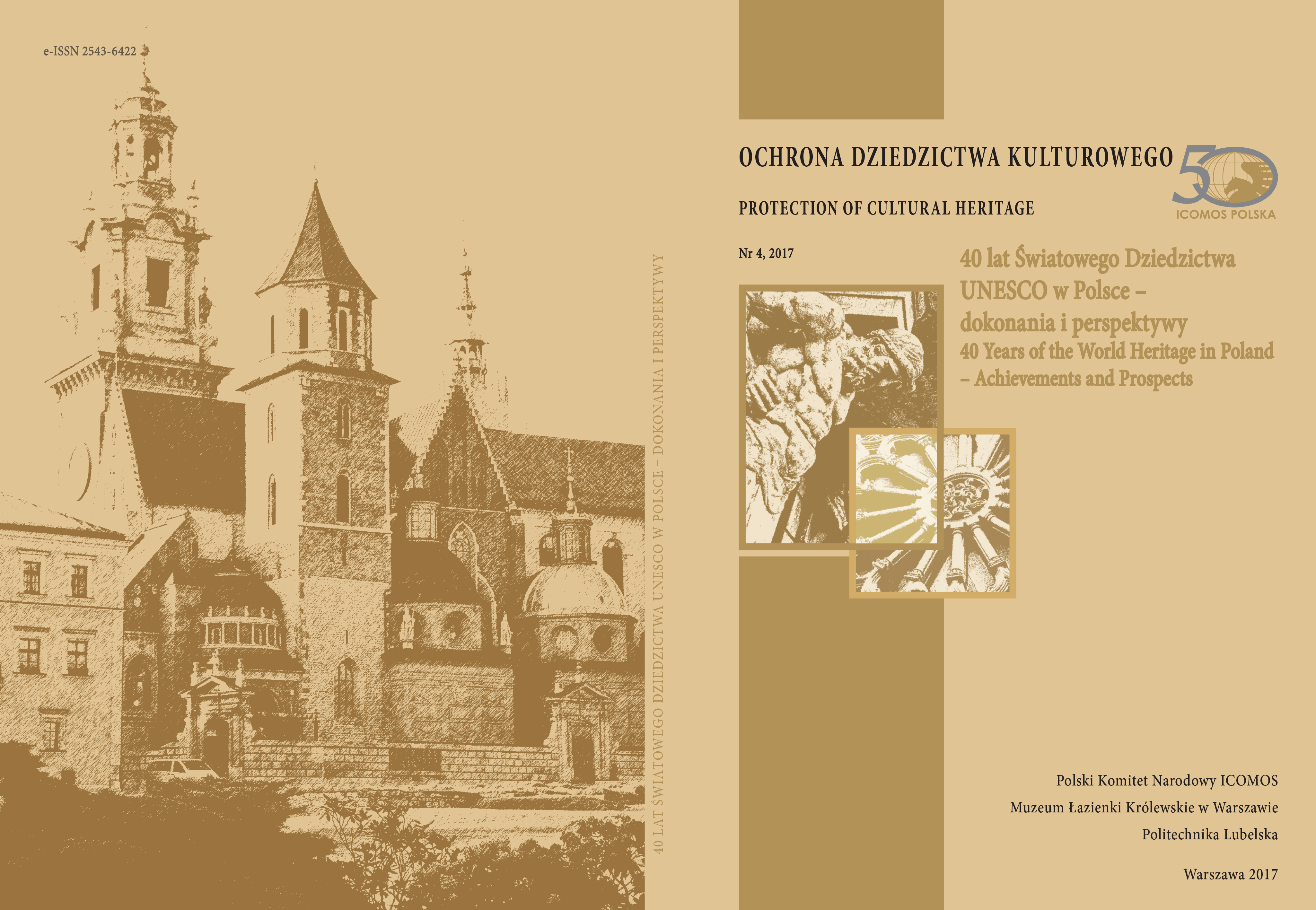Prospects for inscribing certain elements of the cultural landscape of Szczecin as a Polish listed monument
Article Sidebar
Open full text
Issue No. 4 (2017)
-
Civic Committee for the Restoration of Cracow Heritage: origin, experience, programme
Bogusław Krasnowolski7-14
-
Historic monument – the Gniezno Cathedral – the dominant monument of the city landscape now and in the past
Magdalena Meller, Karolina Kowalska15-20
-
Cultural landscape on the World Heritage List - Polish experiences
Andrzej Michałowski21-30
-
Adaptation of buildings of historical significance in Gdańsk. The key issues of Regional Heritage Protection Officers’ perspective
Karolina Szczepanowska31-46
-
Prospects for inscribing certain elements of the cultural landscape of Szczecin as a Polish listed monument
Zbigniew Władysław Paszkowski, Jakub Ignacy Gołębiewski, Izabela Kozłowska47-62
-
Gdańsk on the UNESCO World Heritage List - 20 years of attempts and missed opportunities
Marcin Gawlicki63-72
-
Consequences of entering assets into the UNESCO List – prestige and what next?
Ewelina Kowalska73-81
-
Churches of Peace in Jawor and Świdnica – conservation work of the interior and furnishings, as an example of protecting buildings inscribed on the World Heritage List
Małgorzata Korpała83-92
-
The authenticity of painted decorations of the Old Town in Warsaw
Anna Jagiellak93-103
-
Management Plans for the Churches of Peace in Jawor and Swidnica as an Example of Management Problems with UNESCO World Heritage Site
Waldemar J. Affelt105-120
-
Ideas and assumptions of The Convention concerning the Protection of World Cultural and Natural Heritage and their implementation in Poland from the perspective of the Polish UNESCO Committee
Sławomir Ratajski121-126
-
Poland’s participation in initial efforts to implement resolutions of the Convention
Krzysztof K. Pawłowski127-134
-
The perspectives of protection of the world heritage in Poland – the tentative list and proposals of nominations to the world heritage list
Jakub Lewicki129-142
-
Places of memory under UNESCO 1972 World Heritage Convention and criterion VI of the Op erational Guidelines of its implementation
Wojciech Kowalski149-162
-
The role of the “League of Polish Cities and UNESCO Sites” in the preservation of Cultural Heritage
Zbigniew Fiderewicz163-165
Main Article Content
DOI
Authors
Abstract
This article is an attempt to pay attention to the rich heritage of the capital of Western Pomerania and to contribute to the discussion on the need to raise the monument’s history of its most valuable elements. The cultural landscape of Szczecin, which is a multicultural heritage of the historic Pomerania cultural area, is, by virtue of its origin, a carrier of original, authentic values that are absent in other Polish cities and regions.
According to the authors it is possible to distinguish of three areas, that together reflect the groundbreaking process of spatial development in the history of the city, having authenticity and originality in the country. The first part of the entry should include the historic urban layout of Szczecin’s Śródmieście (Downtown) at the turn of the nineteenth and twentieth century with the form of star and triangular development quarters, as well as urban and architectural and landscape complexes, which are important components of it: Wały Chrobrego (Hakenterrasse), Jasne Błonia (Quistorpaue) and Cmentarz Centralny (Hauptfriedhof).
The spatial and aesthetic qualities, the historical significance and the uniqueness of the particular elements of the aforementioned teams predestine them in our opinion to be included in the list of Historical Monuments.
Keywords:
References
Bizio K., Od kamienicy czynszowej do spółdzielczego osiedla mieszkaniowego, Wydawnictwo Uczelniane ZUT, Szczecin 2017.
Dzieje Szczecina 1806–1945, T. III, (red.) B. Wachowiaka, Wydawnictwo „13 Muz”, Szczecin 1994.
Haas-Nogal M., Kulka I., Kalita-Skwirzyńska K., Studium historyczno-urbanistyczne do miejscowego planu zagospodarowania przestrzennego Gumieńce-Słowieńsko, Szczecin 2002.
Kozińska B., Rozwój przestrzenny Szczecina od początku XIX wieku do II wojny światowej, KAMPOL 2, Szczecin 2002.
Łopuch M., Wały Chrobrego. Hakenterrasse, Stowarzyszenie „Czas Przestrzeń Tożsamość”, Szczecin 2008.
Łopuch W., Dzieje architektoniczne nowoczesnego Szczecina 1808–1945, Książnica Pomorska, Szczecin 1999.
Makała R., Między prowincją a metropolią. Architektura Szczecina w latach 1891–1918, Muzeum Narodowe w Szczecinie, Szczecin 2011.
Słomiński M., (red.) Cmentarz Centralny w Szczecinie. Ogromny park pochował umarłych. Kadruk, Szczecin 2005.
Wohl J., 100 lat Cmentarza Centralnego w Szczecinie, Pomnik Historii Miasta, Agencja Wohl-Press 2007.
Article Details
Abstract views: 303
Zbigniew Władysław Paszkowski, Faculty of Civil Engineering and Architecture of the Szczecin University of Technology/ZUT
prof dr hab. inż. arch., urodzony w 1955 roku w Krakowie, absolwent Wydziału Architektury
Politechniki Krakowskiej, doktorat 1986, habilitacja 1997. Zatrudniony na Politechnice Szczecińskiej
od 1982 roku. Od 2000 profesor ndzw. Politechniki Szczecińskiej/ZUT w Szczecinie. Architekt, założyciel
biura projektowego Urbicon w Szczecinie, autor wielu projektów i realizacji architektonicznych,
modernizacji budynków i publikacji specjalistycznych. Od 2010 prodziekan Wydziału Budownictwa
i Architektury ZUT. Od 2014 profesor zwyczajny.
Jakub Ignacy Gołębiewski, Department of History and Theory of Architecture at the West Pomeranian University of Technology in Szczecin
dr inż. arch., asystent w Katedrze Historii i Teorii Architektury Zachodniopomorskiego
Uniwersytetu Technologicznego w Szczecinie. Autor w działalności naukowej podejmuje kwestie rewitalizacji
przestrzeni poprzemysłowych i frontów wodnych; sztuki w przestrzeni publicznej oraz architektury
tymczasowej. W roku 2016 obronił pracę doktorską pt. „Perspektywy rewitalizacji Międzyodrza
w Szczecinie przy zastosowaniu tymczasowych interwencji przestrzennych”.
Izabela Kozłowska, West Pomeranian University of Technology in Szczecin
dr inż. arch., adiunkt w Katedrze Historii i Teorii Architektury Zachodniopomorskiego
Uniwersytetu Technologicznego w Szczecinie. Absolwentka Politechniki Szczecińskiej, doktorat 2008.
Od 2010 roku adiunkt ZUT w Szczecinie. Architekt, główny projektant wielu realizacji architektonicznych.
Obszar badań naukowych: historia architektury i urbanistyki, dziedzictwo militarne, ochrona
dziedzictwa kulturowego.






